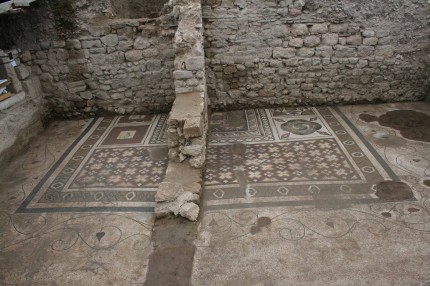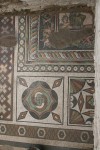
Archaeologists excavating the hill of Aghia Petra on the outskirts of the eastern Greek city of Didymoteicho has revealed an elaborate mosaic depicting sea creatures both beast and divine, Nereids, a river god and the Empress Pompeia Plotina, wife of Trajan. The mosaic once adorned the floor of a triclinium, the formal dining room of a Roman villa, and dates to the 2nd or 3rd century A.D. The characters are centered in the middle of the floor, while the rest of the vast space is dominated by geometric designs and a wide border with a black vine motif on a white background.
 Pompeia Plotina is on the right side of the above picture, in the corner where the two walls meet. Next to her is the god of the Evros river. Frolicking in a border around them are Nereids riding dolphins, ichthyocentaurs (deities with the upper body of a man, the front legs of a horse and the tail of a fish), mermaids, mermen and if you look really closely to the left of Plotina right next to the wall you’ll see two handsome green tentacles.
Pompeia Plotina is on the right side of the above picture, in the corner where the two walls meet. Next to her is the god of the Evros river. Frolicking in a border around them are Nereids riding dolphins, ichthyocentaurs (deities with the upper body of a man, the front legs of a horse and the tail of a fish), mermaids, mermen and if you look really closely to the left of Plotina right next to the wall you’ll see two handsome green tentacles.
“The continuity of the central scene to the [left in the above picture], in particular part of the zone with the sea monsters figures, where the ichthyocentaurs and the Nereids are portrayed, also was revealed”, as [lead archaeologist Matthaios] Koutsoumanis said. “Both [creatures] are seated on a dolphin, and one of them is holding a scarf over the head like a peplos.
It is certain by now that the scene with the Evros river and Plotinopolis is not the only one, as a second panel is coming to light. For the time being, we cannot say what it depicts, as it is covered by the later Early Christian wall. One thing is for sure, however: next year’s excavation has a lot of surprises in store for us,” the archaeologist added.
The mosaic is in excellent condition, despite later subdivisions of the home, with only a few places where the tesserae have been lost. The Early Christian walls cut the room into quarters, it seems, but since the panels on the east side of the higher wall have survived, the team hopes they’ll find the rest when they excavate the west side. Archaeologists estimate that the entire work may be 1400-1500 square feet in area.
 The partial remains of a fresco were also found on the site, although too fragmentary to recognize a specific motif at this juncture. A number of coins discovered may help narrow down which parts of the structure were built when.
The partial remains of a fresco were also found on the site, although too fragmentary to recognize a specific motif at this juncture. A number of coins discovered may help narrow down which parts of the structure were built when.
The city of Didymoteicho, called Dyme in the Hellenistic era, was conquered by Rome in 204 B.C. Three hundred years later in the early 2nd century A.D., Emperor Trajan founded a city next to it a mile from the Evros river and named it Plotinopolis after his wife, a woman with an impeccably virtuous reputation who was known as an adherent to the Epicurean school of philosophy. The town came into its own after its renaming, becoming a major trading post between Trajanopolis (now incorporated into the modern city of Alexandropolis) on the Aegean coast and Hadrianopolis (now Edirne in Turkey) to the north.
 Plotinopolis had its own self-governing assembly and prospered financially, leaving behind an immense archaeological wealth even after its decline. One of the most spectacular finds of the Roman world was made in Plotinopolis. In 1965, soldiers digging a trench unearthed a beaten gold bust of Septimius Severus, now on display at the archaeological museum of Komotini. Regular excavations of the Aghia Petra hill began in 1977 and have continued off and on ever since.
Plotinopolis had its own self-governing assembly and prospered financially, leaving behind an immense archaeological wealth even after its decline. One of the most spectacular finds of the Roman world was made in Plotinopolis. In 1965, soldiers digging a trench unearthed a beaten gold bust of Septimius Severus, now on display at the archaeological museum of Komotini. Regular excavations of the Aghia Petra hill began in 1977 and have continued off and on ever since.
The current excavation project under Matthaios Koutsoumanis began in 1996 and has revealed a number of impressive finds, including inscriptions indicating Plotinopolis was inhabited from the 2nd through the 6th century A.D. The high quality of the recently unearthed mosaic underscores the ancient importance of the city and cements its position as one of the richest archaeological sites in the Greek province of Thrace.
It looks allmost new.
It does. It makes me want to replace all my floors with mosaics.
That mosaic’s some pretty brilliant work! The bust of Severus… wow! One wonders how it ever came to be lost.
It appears to have been portable, used as a military standard and as a symbol of the emperor for swearing oaths. I imagine it must have been hidden at some point in order to have survived the post-Roman deluge without having been melted down.